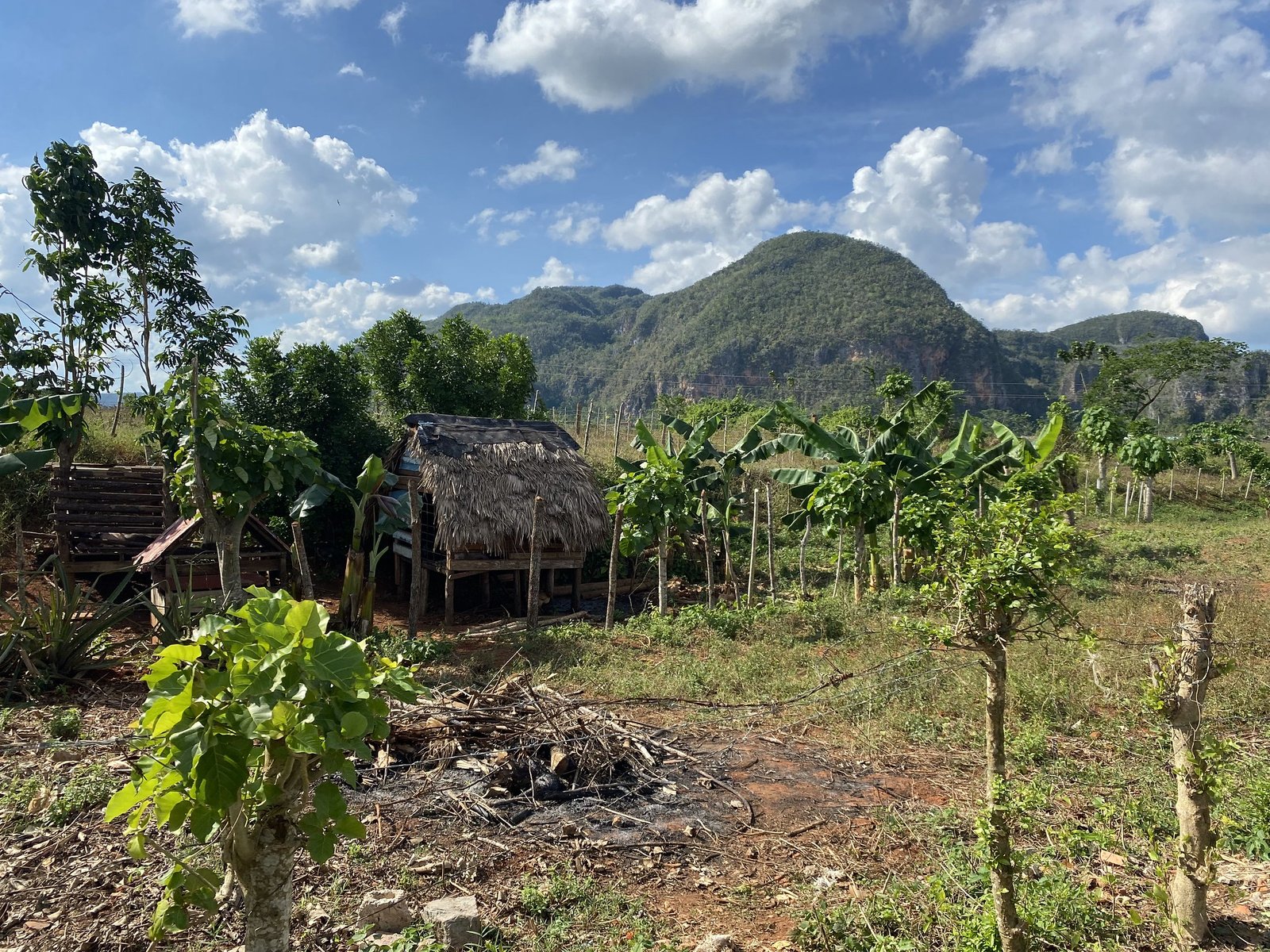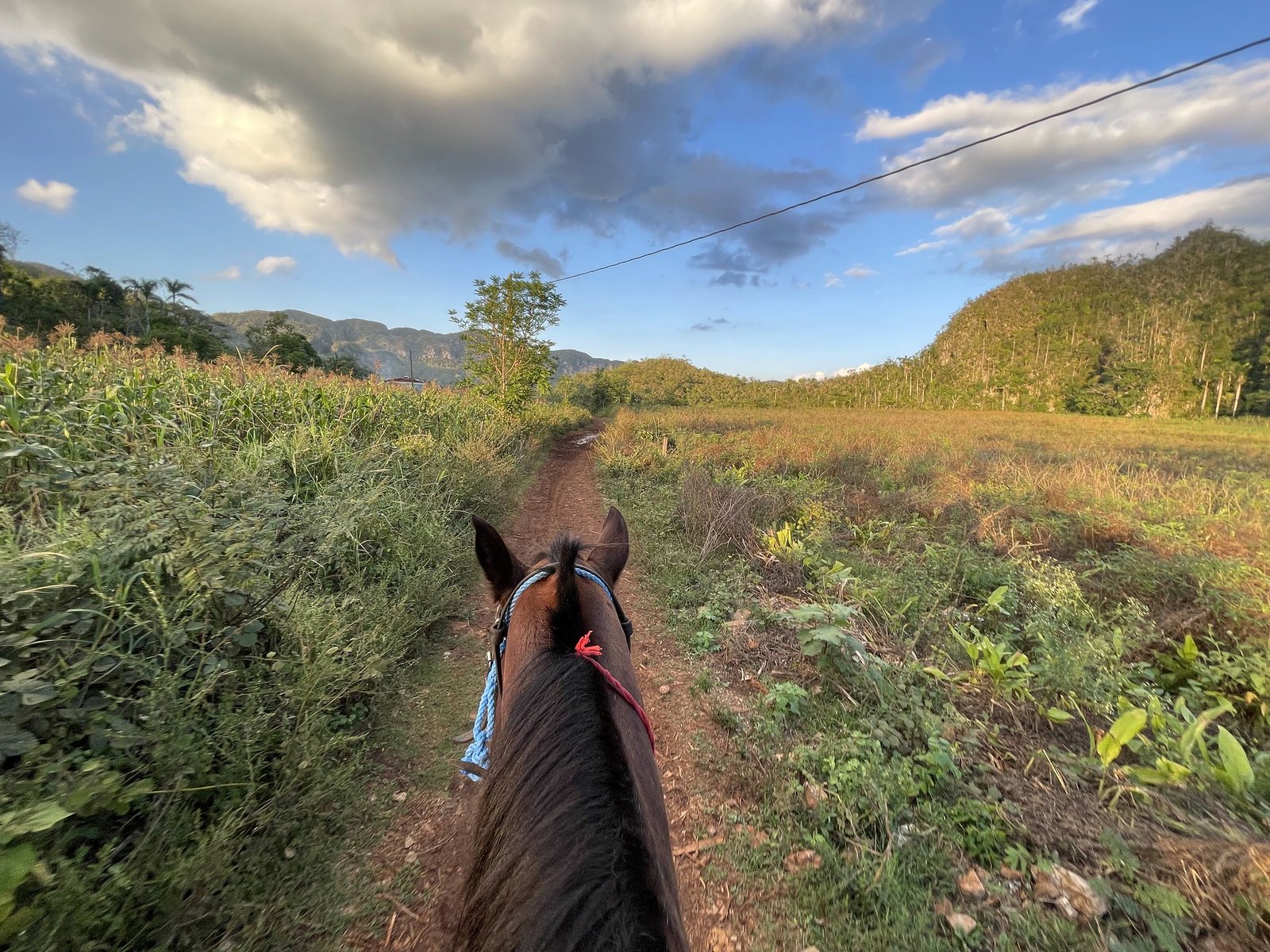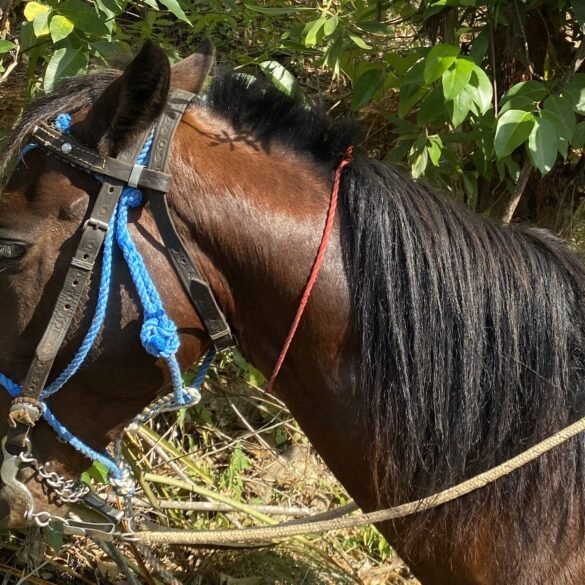“Do you know how to ride horses?” our Airbnb host in Viñales asked.
“Yes!” I answered without thinking. If I had thought about it, the answer would have been, “Yes, I sat on a horse twice this year while the owner led it up a mountain, so I can enjoy a butterfly sanctuary. Also, 10 years ago I spent forty-five minutes riding a mild-mannered horse in an open field in Patagonia, under a watchful eye of a gaucho.”
“Great!” the host said, “Your tour guide will be here soon.”
We had just arrived from Havana in the early afternoon and asked to book a half a day tour to start our exploration of the natural beauty of the Valley of Viñales at once.
As soon as we finished our lunch, our guide arrived and walked us through the town until we reached a yard with three horses tied up in the shade. Victor mounted his horse, Alyassan, a light brown gelding, without much trouble. I, on the other hand, had to be pushed up into the saddle of a dark brown stallion, aptly named Chocolate (choh-koh-lah-teh).
We rode through the town, greeting occasional locals hanging out on the porches of their colorful wooden houses. Eventually, the street gave way to a narrow dirt road with red soil, lined by lush vegetation. All three of our horses walked calmly in a line, my Chocolate seemingly content to be at the back of the pack, while Alyassan proudly taking lead.
“Alyassan! Alyassan!” our guide called out every minute, encouraging Victor’s horse to maintain his speed.
As we entered Viñales National Park, I was able to fully concentrate on the highlights of this UNESCO World Heritage Site and not worry about the horse-riding part of the horse-riding tour. The Viñales valley is encircled by mountains and its landscape is interspersed with dramatic rocky formations known as mogotes. These large, rounded mountains are all that’s left of an eroded limestone plateau that existed here millions of years ago. The mogotes have steep sides and flatter tops covered in ferns, epiphytes, and cork palms. The valley was dotted with small farms, palm trees, and roaming cattle. I marveled at the deep red soil, fertile and perfect for growing tobacco, but unfortunately for the early settlers who named this place Viñales (vineyards in Spanish), not for growing grapes. The vineyards failed, but tobacco, yucca, rice, sweet potato, coffee, sugar cane, beans, and cassava flourish here.



Our first stop, after about an hour of riding, was a cave. The mountain range and mogotes are littered with underground caves, totaling around 45 kilometers in length. There was no visitor center or any indication of a tourist attraction, except for an older man sitting outside the cave with a large flashlight. He greeted us enthusiastically and we followed him inside. Quickly the cave entrance disappeared, and we were submerged in absolute darkness. Our cave guide turned on his flashlight and in the broad light beam, we saw impressive icicle-shaped stalactites hanging from the cave ceiling and massive mound-fashioned stalagmites rising out of the floor. We walked gingerly on the uneven cave floor, stepping over puddles, small stone dams, and calcite deposits. A few wooden boards were laid across wider water streams, but the trail we followed was impossible to adhere to without a guide. He walked confidently ahead into the dark, his flashlight shining back at us so we could see our path.
Finally, we arrived at our destination - a beautiful underground swimming lake with curtain-like sheaves of flowstone draping from the surrounding ledges. Our cave guide turned his back to us and sat on a rock, while we fumbled in the dark, changing into our swimming suits.
The water was cool, clean, and crystal clear. As soon as I plunged into the lake, I could see how dark and deep the water was just a few feet away from the rocky shore. There was no vegetation, no living creatures, just water and rock formations. We swam into the darkness, our voices and the sounds of splashing water echoing through the cave. This very much reminded me of visiting cenotes in Mexico, except we were the only ones there.
After drying off and changing back into our clothes, we were led back out of the cave, still marveling at the natural formations around us. Squinting into the sudden bright daylight, we mounted our horses and took off towards the next stop, Mural De La Prehistoria. No, this is not a prehistoric mural, but rather a modern rock painting depicting world history from murky primitive beginnings to the age of humans. The mural starts with curled-up mollusks and various ancient sea organisms, moves on to the age of the dinosaurs, and ends with three giant red human figures.


On our way there, my horse, Chocolate, quickly took the lead and trotted confidently ahead.
“Chocolate! Chocolate!” our guide called out, encouragingly.
Happy that the trail view was no longer blocked by Victor’s horse’s butt, I was immersed in taking pictures and videos when Chocolate suddenly lurched underneath me. Apparently, Alyassan tried to sneak by and overtake us while Chocolate slowed down to literally smell the flowers. Unhappy with being delegated to the back again, Chocolate swung his head at Victor’s horse, loudly snorted, and jerked forward into a quick trot. All I saw was Victor’s confused face as I tried desperately to hold on to the saddle and reins.
“Chocolate!” our guide screamed, followed by a stream of angry Spanish.
“Sorry!” I called back at Victor, “But it’s our turn at the front!”
We arrived at the painted rock face and took our time studying the painting and posing in front with our horses. Back on my horse, I could feel how tired my back and legs were from three hours of riding. I was wondering how hard tomorrow would be with a full day of horse riding with already sore muscles. Ready for a quiet ride back home, I did not expect that the feud between Chocolate and Alyassan was just getting started.
As we took off, the horses immediately got into another squabble about who would take lead, Chocolate angrily galloping ahead, as I barely held on. Alyassan refused to give up, constantly catching up to us and trying to bite Chocolate’s rear end.
“Chocolate!” exasperatedly yelled the guide, “Alyassan!”
He maneuvered his own horse between ours, trying to diffuse the developing situation. It worked for a little while until Chocolate lingered at crossroads, unsure which path to take and Alyassan took that moment to charge ahead. As soon as Alyassan pulled forward, Chocolate reared his immense body, angrily stumped his front legs, and landed a giant bite on Alyassan’s neck. Alyassan screamed, pulled away, and stumbled into the bushes. Holding on with all my might to the saddle, I briefly saw Victor and his horse floundering in a circle through the thorny vegetation, before Chocolate trotted victoriously ahead, carrying me away.
“Are you ok?” I yelled, unsure if I was addressing Victor, Alyassan, myself, or our frustrated guide.
As we kept riding, Alyassan seemed to lose all his confidence and in fact, his will to keep on walking at all. Upset at being attacked, he loitered at the back, slowing down with every step. Victor, who could never hurt any animal, rejected our guide’s instructions to whip the horse or sharply push stirrups into his sides. The whole way home, Alyassan hung his head down and sluggishly ambled down the path, while Victor gently patted his sides and gave him encouraging pep talks.
Back at the village, we dismounted and bid our horses and our guide goodbye until tomorrow.
“He is a sensitive soul and a perfectionist.” Victor said, patting Alyassan, “Just like me.”
“He is a winner and a bit of an asshole,” I said, glancing at Chocolate, “Just like me!”



